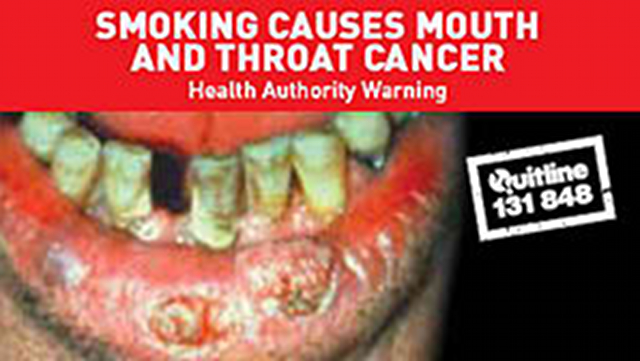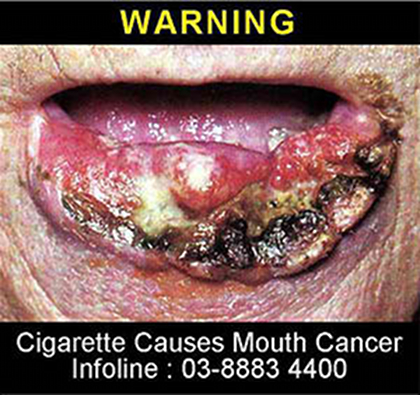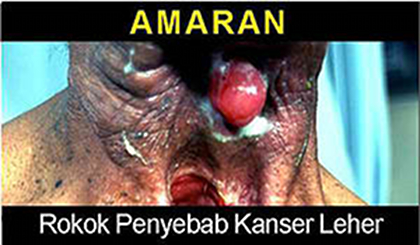SUMMARY
This is AI generated summarization, which may have errors. For context, always refer to the full article.

MANILA, Philippines – “Government warning: Cigarette smoking is dangerous to your health.”
For two senators, these words are no longer enough to discourage Filipinos from smoking. Instead, Senators Pia Cayetano and Franklin Drilon want you to see warnings like these:




The images are sample graphic health warnings on tobacco packages in countries like Australia, Thailand, and Singapore. The two lawmakers believe it is about time the Philippines has a law mandating similar warnings to urge smokers to kick the habit, and to discourage others from trying.
Cayetano and Drilon filed separate bills in what the female senator described as a revival of the fight against the tobacco lobby in the 16th Congress.
The two senators, who also worked for the passage of the sin tax reform law last year, said that making cigarettes more expensive is not enough to get Filipinos to stop smoking.
In separate statements on Thursday, July 11, Cayetano and Drilon said studies show graphic health warnings are the most effective means of communicating the dangers of smoking.
“As our historical experience with raising sin taxes would show, smokers tend to shift to lower-priced brands to be able to sustain the habit,” Cayetano said.
Under their measures, government will require tobacco companies to print graphic health warnings on at least 60% of the upper front and upper back parts of the cigarette pack.
Cayetano also wants one side of the pack to bear additional textual health warnings, hotlines, or websites for tobacco-related concerns or tips on how to stop smoking.
In the Drilon version, the companies will also be mandated to simultaneously print 8 variations of graphic warnings. These will be rotated periodically.
Both bills also prohibit tobacco packages from containing descriptions suggesting that a variant or brand is safer than the other. These include words like “reduced levels” of substances, contents and emissions, “low-tar,” “light,” and “mild.”
“There is no such thing as a ‘safe’ or ‘less harmful’ cigarette, that’s why we intend to do away with such misleading descriptors,” Cayetano said.
Drilon’s bill imposes a fine ranging from P1 million to P20 million and/or imprisonment of not more than 5 years for those who violate the law.
Health hazards, global commitments
Cayetano and Drilon argued for the effectiveness of graphic health warnings.
Drilon said that a study of the Center for Disease Control in Atlanta showed that warning labels affected more than 25% of people in 14 countries from 2008 to 2010.
“Other studies have shown that the use of graphic images on packets have a significantly wider reach than mere text warnings, as images produce effects not just on the smoker, but on the people around him,” Drilon said.
“It has also been apparent that these images have a significant effect on those who have difficulty in reading and writing,” he added.
Drilon said the Philippines has one of the highest smoking incidences in the Western Pacific region. He said over 17 million Filipinos aged 15 years and above smoke an average of 10.7 sticks of cigarette a day, according to the 2009 Philippine Global Adult Tobacco Survey.
Cayetano also said data from the Health and Finance Departments show annual smoking-related deaths are estimated at 48,499 and the social costs of smoking at P177 billion.
Lung cancer, chronic obstructive pulmonary diseases, coronary heart disease and stroke are just some of the illnesses linked to smoking, said Cayetano.
The senators though admit they face an uphill battle in pushing for the bill.
Cayetano said she sponsored two versions of the measure in the 14th and 15th Congress, but these failed to pass because of strong opposition from the tobacco industry.
The House of Representatives also killed the bill in 2008.
READ: Congressmen gang up on anti-smoking graphic warning bill
Cayetano and Drilon also experienced fierce opposition in passing the sin tax reform law, with senators from tobacco-producing regions staunchly blocking the measure.
Yet the Philippines has international commitments to pass a graphic health warning law. This includes the World Health Organization’s Framework Convention on Tobacco Control (FCTC), where the country committed to pass the law by 2008.
Australia, another FCTC party, was able to pass the law, and even added another requirement: to make all tobacco products have plain, unattractive dark olive green packaging.
READ: Look, mate, scary cigarette packs!
“I am hopeful that we will have more colleagues who would stand up for the interest of public health when the GHW bill is tackled in the committee and plenary levels,” Cayetano said.
Do you think graphic health warnings are effective? Is it time to pass the bill? Let us know in the comments section below. – Rappler.com
Read the Drilon bill here:
Add a comment
How does this make you feel?
There are no comments yet. Add your comment to start the conversation.